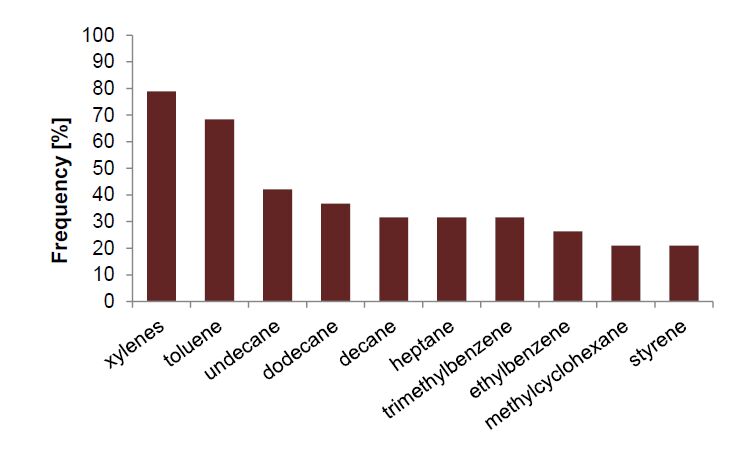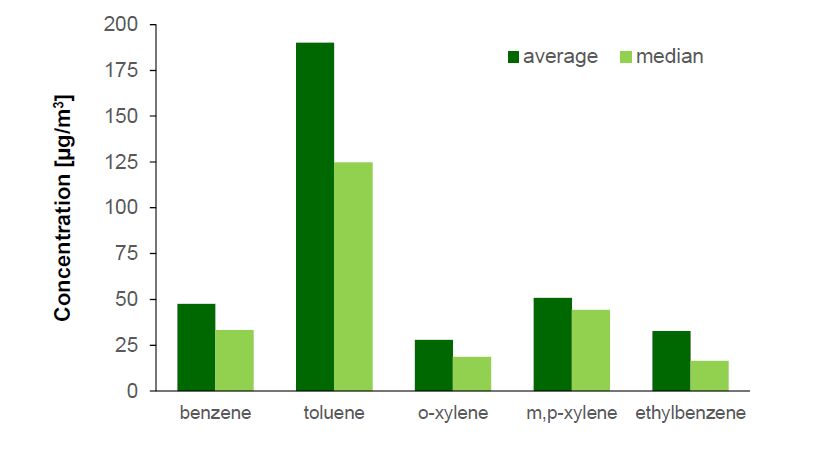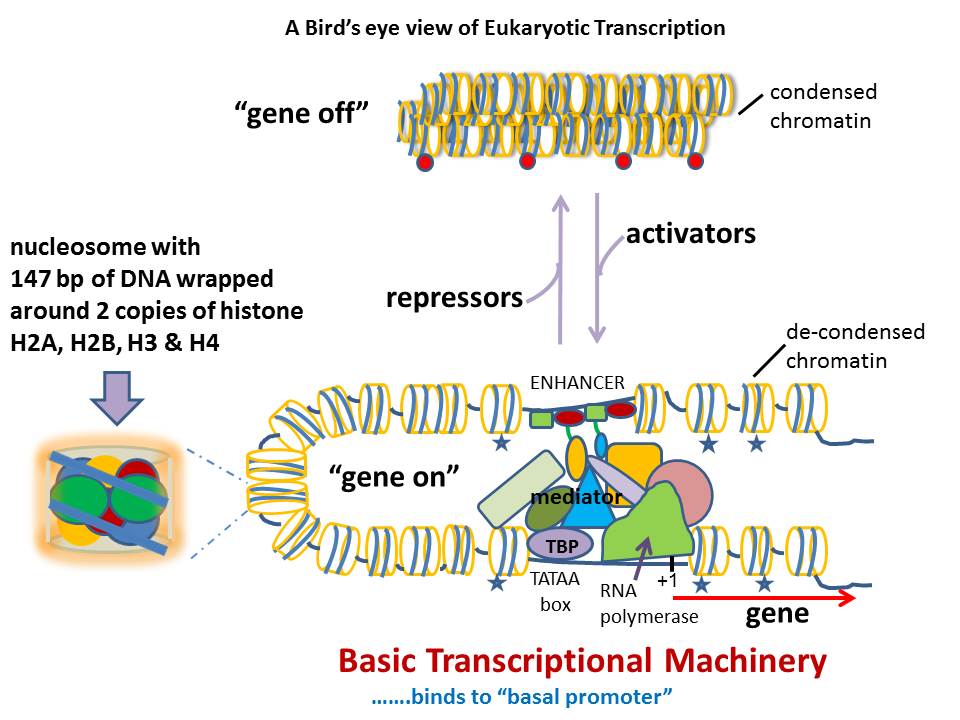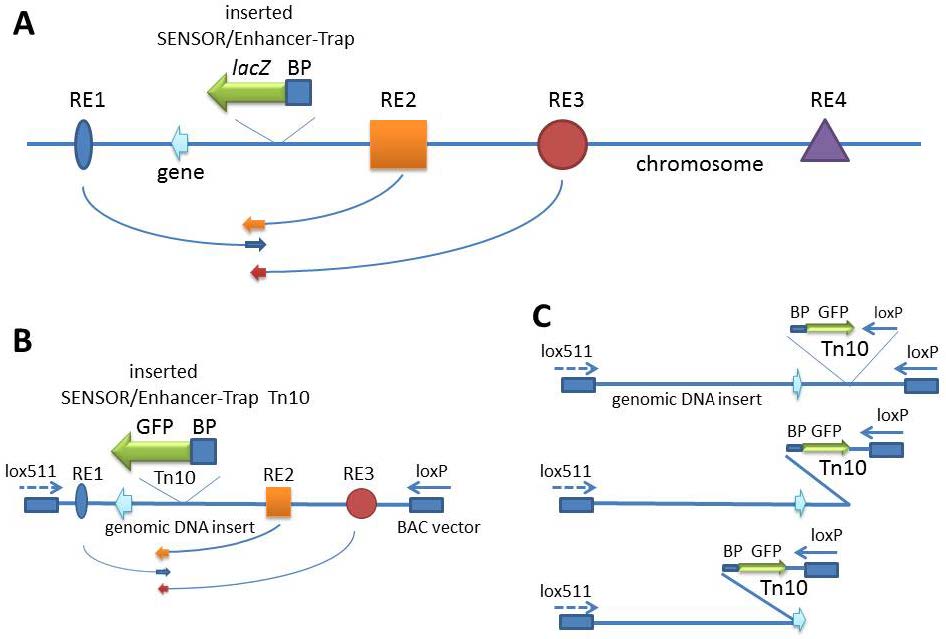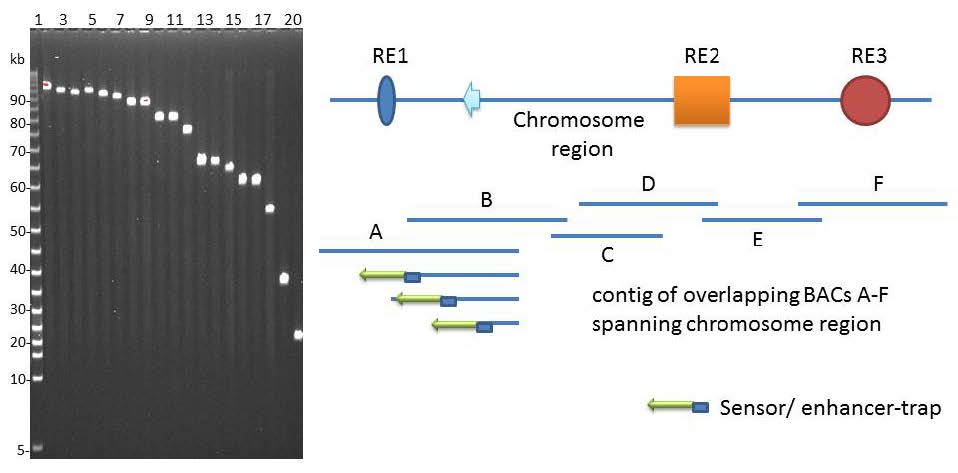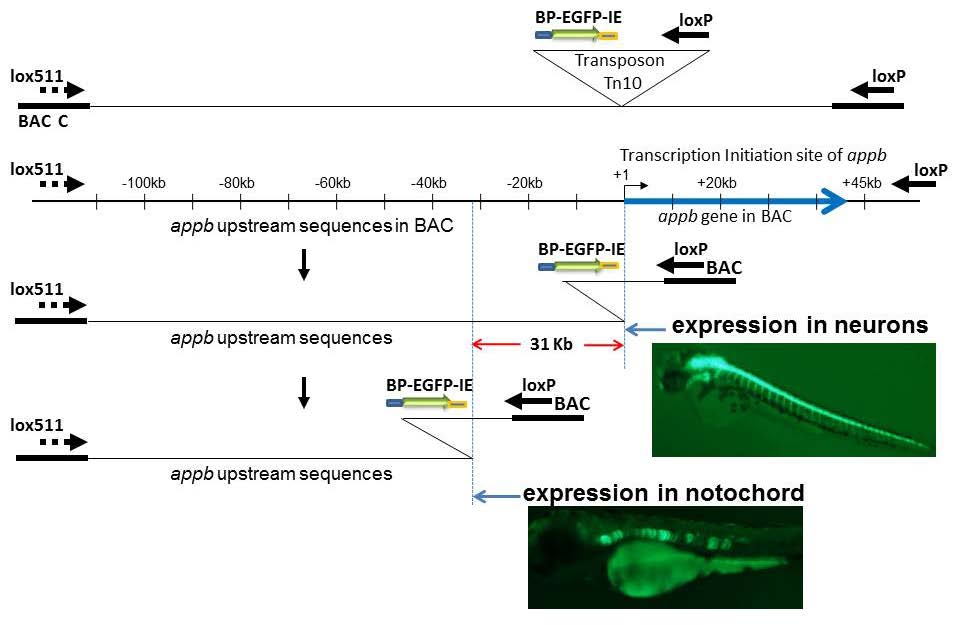There is renewed interest in understanding expression of vertebrate genes in their chromosomal context because regulatory sequences that confer tissue-specific expression are often distributed over large distances along the DNA from the gene. One approach inserts a universal sensor/reporter-gene into the mouse or zebrafish genome to identify regulatory sequences in highly conserved non-coding DNA in the vicinity of the integrated reporter-gene. However detailed mechanisms of interaction of these regulatory elements among themselves and/or with the genes they influence remain elusive with the strategy. The inability to associate distant regulatory elements with the genes they regulate makes it difficult to examine the contribution of sequence changes in regulatory DNA to human disease. Such associations have been obtained in favorable circumstances by testing the regulatory potential of highly conserved non-coding DNA individually in small reporter-gene-containing plasmids. Alternative approaches use tiny fragments of chromosomes in Bacterial Artificial Chromosomes, BACs, where the gene of interest is tagged in vitro with a reporter/sensor gene and integrated into the germ-line of animals for expression. Mutational analysis of the BAC DNA identifies regulatory sequences. A recent approach inserts a sensor/reporter-gene into a BAC that is also truncated progressively from an end of genomic insert, and the end-deleted BAC carrying the sensor is then integrated into the genome of a developing animal for expression. The approach allows mechanisms of tissue-specific gene expression to be explored in much greater detail, although the chromosomal context of such mechanisms is limited to the length of the BAC. Here we discuss the relative strengths of the various approaches and explore how the integrated-sensor in the BACs method applied to a contig of BACs spanning a chromosomal region is likely to address mechanistic questions on interactions between gene and regulatory DNA in greater molecular detail.
1.
Indoor air pollutants
1.1. Classification of air pollutants
The pollutants present in indoor and outdoor air may undergo different classifications in respect of their nature: organic or inorganic; physical state: gas, liquid, solid or in broader view as disperse systems; particle sizes; biological or non-biological origin, etc. They are present in air as a complex mixture, which, inter alia, consists of [1,2,3]:
- organic compounds in form of gases or particles,
- inorganic compounds, such as carbon oxides, nitrogen oxides, radon, ozone,
- particles, such as dust and fibres,
- biological particles, such as bacteria, fungi, mould.
Organic compounds are often divided into four groups on the basis of their boiling points (Table 1) [4,5].
Taking into account that organic compounds in interior environment originate mainly from materials off-gassing, some general remarks can be drawn. Very volatile organic compounds are present at room temperature in the form of gases, because they have low boiling points (< 100 °C), and their off-gassing from materials is relatively fast [2,6]. Semi-volatile organic compounds are compounds with boiling temperatures above 240-260 °C, and among them mainly phthalates, long-chain alkanes, polychlorinated biphenyls (PCBs), fatty acids and their esters, phosphate esters, and others can be found. These compounds can be present in indoor air for several years from their introduction, since they are removed from materials relatively slow [7].
1.2. Impact of volatile organic compounds on human health
Organic compounds, which are present in air, may both influence human comfort and have a negative impact on human health. Selected compounds are responsible for [8,9]:
- drowsiness (e.g. saturated and unsaturated aliphatic hydrocarbons, cyclohexane, ethylbenzene, 1-butanol);
- headache and dizziness (e.g. hexane, heptane, cyclohexane, toluene, naphthalene, trimethylbenzene);
- eye irritation (e.g. 2-ethylhexanol, benzaldehyde, styrene, propylbenzene);
- respiratory problems and throat irritation (e.g. styrene, methyl cyclopentane, decalin);
- fatigue, nausea, skin irritation,
- may have toxic, carcinogenic or mutagenic effect, and many others.
Negative health effects were confirmed in case of many organic compounds [10]. Many of those compounds have irritant effect on eyes, throat and respiratory system. Moreover, for selected compounds some other serious effects were found:
- benzene: has a strong negative effect on central nervous system, can cause genetic diseases, anaemia and other circulatory system diseases, may cause fatigue, somnolence and headache. Moreover, benzene was classified as carcinogenic compound [10,11,12,13,14],
- toluene: has a negative effect on central nervous system and respiratory system, causes headache, nausea, has impact on awareness, reproduction and hormonal system [10,12,14],
- styrene: has a negative neurotic effect, can cause genetic illness and may have a carcinogenic effect [14],
- naphthalene: causes genetic disease, cells destruction and anaemia [11],
- isomers of trimethylbenzene: each isomer causes somnolence, headache and nausea. The most often found in air is 1,2,4-trimethylbenzene. [12],
- aldehydes (especially formaldehyde, acetaldehyde, acrolein): are known to be toxic, mutagenic or carcinogenic. They are known both respiratory system and eye irritants and their inhalation may increase the likelihood of respiratory illness [10,15].
Some of organic compounds has both short- and long-term activity, and negative health effects may appear even after few years after exposition, even if compounds' concentrations in air were at low level [4,16]. In vehicle, driver and passengers are exposed to relatively high concentrations of VOCs in car cabin [17]. When present in vehicle interior, organic compounds may also influence driving safety. Besides aforementioned health effects, semi-volatile organic compounds with boiling temperatures above 240-260 °C [5], mainly phthalates, condensate on interior surface of glass windscreen, reducing the transparency and causing light reflections. This phenomenon is called fogging [18,19].
Many of organic compounds have both irritating and odorous character. People usually can recognize air quality on the basis of surrounding odour [20], and odour-effect usually appears faster than irritation-effects [4]. Human nose is a very sensitive odour detector, capable to detect odorous substances on very low concentration level [21]. On the other hand, odour perception is very subjective and for that reason people can recognize differently the same odour. Moreover, even if specific odour is recognized as a pleasant, after long-term exposure may lead to odour annoyance and discomfort [22].
On the basis of total volatile organic compounds (TVOC) concentration some sensitivity thresholds values can be defined (Table 2, [16]). To our best knowledge, these threshold values have not been confirmed in scientific researches yet. For that reason it is difficult to establish precise guidelines or legal requirements [23].
1.3. VOCs sources in vehicle interior
Indoor air can be polluted by several hundred different organic compounds, including aliphatic and aromatic hydrocarbons, benzene derivatives, carbonyl compounds, halogenated derivatives of hydrocarbons, polycyclic aromatic hydrocarbons (PAHs), and others.
The cabin of a vehicle is regarded to be a specific indoor microenvironment [24,25,26,27,28,29,30,31,32,33]. The vehicle interior is a closed space in which harmful compounds are concentrated, even if initially they are present at low concentration levels or their emission is relatively low [29,34]. The concentrations of different compounds in the passenger compartment are usually higher (even 2-3 fold) compared with the concentrations of these compounds in other closed environments, where people spend their time (residential, workplace, public buildings, hospitals, and others) [24,29,35,36].
Volatile organic compounds are the main air pollutants inside the new vehicle. For emission of VOCs into the cabin air in majority plastics are responsible, among them polystyrene, polyethylene, polypropylene, polyamide, polyester, polyacetal, acrylonitrile-butadiene-styrene, and others. The next sources of VOCs are rubber, natural or artificial leather, textiles, fibres, polyurethane foams, coatings, adhesives and others. Those materials are used to produce components in the cabin interior: dashboard, steering wheel, insulations (plastics), seats and couch, wrapping of the steering wheel (artificial or natural leather), upholstery, soundproofing, roof ceiling, floor mats, seat covers (textiles and fibres) [16,24,25,33,35,37,38,39,40]. The most commonly used material in the automotive industry is polyester, used among others for production of seat covers, floor mats, seat belts and others. Other materials, used to equip vehicle's interior are, for example, polyamide 6 and 6.6, and polypropylene (floor mats), polyethylene and poly(vinyl chloride) (headrests), polyurethane (seats, headrests) [41]. Among all these materials, natural leather is probably the biggest source of emissions of volatile organic compounds [18,37].
1.4. Emission of VOCs from materials
The composition of VOCs, emitted from materials, is quite complicated mixture and difficulties in identification of organic compounds source may occur. Such difficulties are affected by the fact, that there are many indoor sources of VOCs emissions, and one compound can be emitted by different materials [20]. Additionally, some metallic or other inorganic elements can also be the source of organic compounds emissions due to the VOCs accumulation on the element's surface and their subsequent gradual release [42]. On the other hand porous materials can act as sorbents, therefore VOCs emitted from one material can be adsorbed on the surface of the other material [43,44].
Emission from materials, called "materials off-gassing", can be divided into primary and secondary emission [45,46]. It is assumed that the primary emission of VOCs from materials is the emission which takes place during the first year after material production date. Emitted VOCs are mostly low-molecular organic compounds (i.e. solvent residues, additives and monomers). The secondary emission takes place over one year after material manufacture/introduction to indoor environment and is mostly connected with organic compounds which are products of degradation, hydrolysis or oxidation reaction, and others. The concentration of the compounds resulting from the secondary emission is usually several orders lower than from the primary emission [47].
The amount of volatile organic compounds emitted from materials used to equip vehicle interior depends on several factors, including air temperature and relative humidity (RH) inside vehicle, the air exchange rate, type of material and the age of vehicle [25,35,37,38,48]. None of indoor environment can be recognized to be static, because temperature and humidity of air changes within time, which affects VOCs emission [2,7,47]. Along with the atmospheric conditions changes the change of organic compounds concentration takes place [1,7,34]. In summer days, when car is exposed to direct sunlight, air temperature in cabin can exceed 65 °C, and the most exposed to sunlight piece of equipment is a dashboard, which temperature may be even higher [41]. A significant dependence of VOCs concentrations inside the cabin on air temperature was confirmed in many studies [12,24,37,40,49]. It should be taken into account, that driver entering vehicle interior, where the air temperature is high, is exposed to maximum temporary VOCs concentration level [12].
Increased temperature in vehicle interior leads to solvents, various types of additives and other compounds, such as toluene for example, evaporation from materials [38]. Previous studies of vehicle conditioned in an environmental chamber have shown that at a temperature of about 50 °C, the total emission of VOCs in vehicle interior may be even eleven times higher than at ambient temperature (about 20 °C). With the temperature increase inside the cabin, emission of heavier hydrocarbons and their methyl derivatives also increased [49].
Many scientific researches on emission of harmful compounds from materials are available, however, multiplicity of materials causes that still little is known about the impact of different materials and their interactions on air quality in closed environment of car cabin. It was found that among the compounds, typically emitted into vehicle interior, are acetaldehyde, formaldehyde and xylenes [12], however it is very difficult to indicate clearly one source of those compounds. Ethylbenzene, for example, may be emitted by insulating and soundproofing foams, varnishes and degreasing agents, while emission of undecane may have source in paints and solvents [2].
Elements made from poly(vinyl chloride), like skin texture imitating materials, are the main source of 2-ethyl-1-hexanol [50,51,52]. It was found that ethylbenzene and styrene are specific compounds emitted from polystyrene, both in ambient and elevated temperature. Benzaldehyde, nonanal, tridecane, decanal, and diethyl phthalate can be emitted at 23 °C from polyethylene, while in higher temperature (70 °C) 2-ethyl-1-hexanol was additionally detected [52]. Additionally, polyethylene may emit inter alia acetic acid, aldehydes, ketones, esters, terpenes, benzene, toluene, naphthalene and wide range of other compounds. Polyamide 6.6 is the source of emission of its degradation products, i.e. cyclopentanone, pentanoic acid and 1-methyl-2-pyridine [51]. The main compound, which is usually emitted from polypropylene, is 2,2,4,6,6-pentamethylheptane, regardless the temperature, while polyurethane foam emits inter alia toluene, phenol, decane, nonanal, benzaldehyde, diethyl phthalate etc. at ambient temperature [52].
The floor mats are usually the source of styrene, ethylbenzene, hexane and toluene [33,42], while upholstery made from natural leather is the source of alcohols and 1-methyl-2-pyrrolidone. Steering wheel covered with natural leather emits much more carbonyl compounds and furans than steering wheel made from polyurethane [53].
Mentioned above compounds, which can be emitted from materials, were measured in test conditions, usually after conditioning in glass vessels. It should be pointed out, that test conditions may differ significantly from real conditions [54]. Complexity of chemical composition of air in vehicle interior is also affected by the fact, that multiplicity of different materials are used in small closed space, and each of them is a potential source of air pollution. The situation is also complicated by the fact, that there are many suppliers of similar car components and differences in material's manufacturing process, resulting in different emission rates, may occur. The quantity of organic compounds emitted from materials depends mainly on quality of particular processing steps, and being influenced by, inter alia, material and its residual moisture, mould temperature, residence time, cooling rate, hot spots etc. [55]. Additionally, plastics are often enriched by different additives to achieve desired properties. Among those additives plasticizers, stabilizers or flame retardants can be found [19].
2.
Air quality in vehicles
Despite the fact, that car is a very often used mean of transport, vehicle interior is not well recognized indoor environment, especially in comparison to other indoor environments. It is mainly connected with the fact, that many car brands and models with different interior equipment and many car producers are present on the market.
The driver and passengers may spend in vehicle interior even 8% of the day, commuting from home to work, traveling during private or business activities [37,53,56,57]. Therefore, persons traveling in automobiles are exposed to, inter alia, the presence of various aromatic hydrocarbons [6,12,24,58,59,60,61,62], aldehydes [24,26,27,28,29,30,63], and phthalates [24], further on carbon monoxide [29,64,65], nitrogen oxides [29,65], particulate matter [29,31,58,66], polycyclic aromatic hydrocarbons [60], and others.
Chemical composition of air inside vehicle differs qualitatively and quantitatively for new cars in comparison to older vehicles [38]. In new car, in which VOCs emission from materials is the highest [33,37], there are present mainly low molecular weight volatile organic compounds. Concentrations and types of organic compounds present in new car cabin, obtained during different scientific researches, are presented in section 2.1.
Along with the time of vehicle usage, emission of organic compounds from materials is gradually replaced by emission from so-called moving external sources, that is, for example, the combustion of fuel, fuel leakages and others [57]. The concentrations of VOCs in driven cars depend on many factors, among them the model of the car, it's construction and the related exchange of air, season and weather conditions, time and travel routes, traffic congestion, fuel distribution, and others [35,67,68,69]. The summary of air quality studies in used vehicles is presented in section 2.2.
The number of researches carried out in terms of human exposure to in-vehicle pollution associated with communication traffic is relatively high, however, there is only few research on air quality in new vehicles connected with materials off-gassing [33,35,53,62], or the number of vehicles under study is limited [25].
2.1. Air quality inside new vehicle cabin
In most of researches on in-vehicle air quality, air samples were collected under static conditions, which means that the engine was shut off and all doors and windows were closed. In most cases vehicles were conditioned at specified temperature before air sampling. Static conditions and conditioning of vehicle under study ensured homogenous distribution of organic compounds in vehicle compartment.
The concentrations of VOCs in parked vehicle (static conditions) were significantly higher than in vehicle during the test under normal operating conditions (vehicle moving) [17]. This conclusion was confirmed in studies performed by Fedoruk and Kerger [40], on the example of a 4-year-old vehicle, found that concentrations of 10 major compounds were higher in static than in dynamic conditions (vehicle in traffic). Moreover, qualitative air composition was dependent on air sampling conditions.
The summary of results obtained during studies on air quality in the cabin of new vehicles is presented in Table 3. Vehicles with the age under 3 years were considered as new ones. Only few studies concentrated on vehicles directly after manufacturing are available [70,71,72,73,74,75]. The sum of determined organic compounds differed significantly in different vehicles, depending on test conditions, and ranged from 136 to 14,081 µg/m3. Another factor influencing quantity of organic compounds determined, were differences in air sampling procedure and preparation of vehicle before air sampling.
Comparison of main compounds frequency in new vehicles is presented in Figure 1. This comparison is based on data presented in Table 3 and presents ten main compounds which were found in new vehicles cabins the most frequently. Among those compounds, isomers of xylene were found as one of main air pollutants in majority of vehicles under study (79%). Another compound frequently detected in new vehicles interiors on elevated concentration level was toluene (68% vehicles), which is consistent with statements in chapter 1.4 (emission from materials). On the other hand, those compounds may also originate from exhaust gases, when vehicle is in road traffic.
Concentration of main air pollutants in new vehicles varied significantly, i.e. toluene range was: 5.5-2000 µg/m3; xylenes: 9.4-2500 µg/m3; undecane: 40.0-1615.8 µg/m3; dodecane: 44.5-928.9 µg/m3; and decane: 16.0-1300.6 µg/m3. These differences originated probably from differences in vehicles' age, and differences in materials used.
Chien [37] found that intra-model variability (expressed as a coefficient of variation between different examples of the same model) for 12 organic compounds was on average 47%, and between different brands (inter-brand variability) it was 95%. This means that air composition, determined in one example of vehicle model can be transferred with approximation of 47% to another vehicle example of the same model. The differences in the concentrations of volatile organic compounds in different vehicle brands are so significant, that air composition in one vehicle brand cannot be directly transferred to another brand. Chien performed researches on 12 most common organic compounds, in five different vehicles. On this basis it was found that the concentrations of determined compounds varied significantly, depending on the vehicle model. On the other hand, Faber et al. in their studies investigated changes of key compounds (benzene, toluene and xylenes, BTX) in eleven new vehicles of the same model. They found, that concentration of BTX compounds was as follows: benzene 2.1 ÷ 28.0 µg/m3, toluene 8.9 ÷ 156.6 µg/m3, xylenes: 37.3 ÷ 198.2 µg/m3, depending significantly on the vehicle example [70]. In other study, Faber et al. found that compounds like benzene, toluene, ethylbenzene, xylenes, naphthalene, methylcyclohexane, 3-methylhexane, octane, decane, undecane, dodecane, tridecane, cyclohexanone etc. were found in all nine vehicles tested [71]. Fedoruk and Kerger found that toluene, styrene and alkanes were present in all three vehicles tested [40].
Buters et al. [75] conducted a study on two vehicles of the same type with the same interior equipment. One car was new (about one month after production date) and one was used (about 3 years-old). It was found that the concentration of organic compounds in a new car was ten times higher than in used car. On the basis of above mentioned studies, it can be stated that not only compounds concentrations change with the vehicle usage, but also changes the quantity of VOCs. You et al. [38] identified 82 compounds in one new vehicle, whereas in the one-year-old vehicle they found 61 compounds, and only 36 compounds in five-year-old.
Presented results differ in terms of number of vehicles tested and number of VOC analysed. For example, Zhang et al. [57] conducted a study on 802 different new cars, but they analysed only four organic compounds. They found that toluene was the predominant air pollutant in all vehicles cabins. In another study, Yoshida and Matsunaga [35], determined 161 organic compounds, however, the subject of their research was only one new private car. The widest range of research, both in terms of the number of vehicles tested and the number of identified organic compounds, was conducted by Yoshida et al. [25,53]. During their study air samples were collected from 101 Japanese cars. In air samples a total number of 275 organic compounds were identified, and TVOC depended significantly on the model and age of vehicle tested, varying from 136 to 11,398 µg/m3. From all determined compounds, 242 were present in all vehicles tested.
Some studies were focused also on the influence of materials in vehicle interior on air quality, VOCs concentrations and their types changes. Brodzik et al. [72] investigated the influence of interior materials change (colour of steering wheel, changes in upholstery, introducing of sunroof or convertible roof) on concentration of organic compounds. They found that intra-model variability in identically equipped cars was below 14%. Introducing sunroof into vehicle with the same interior equipment caused increase of TVOC by 1.6 times. On the other hand changes in upholstery materials in vehicles with sunroof caused increase of TVOC 2 times. Effect of trim materials was also described by Xu et al. [17], who found that in cabin with leather trim concentrations of benzene, toluene, xylenes, styrene, acrolein with acetone were higher than in cabin with fabric trim, while formaldehyde concentration was on similar level, regardless trim material.
To sum up, in most of the vehicles under study the main air pollutants were aliphatic hydrocarbons, accounting from 42 to 59% of TVOC [25,35,38,53], then aromatic hydrocarbons, accounting from 16 to 42% of TVOC [25,35,53]. Cycloalkanes, chlorinated hydrocarbons, terpenes, esters, and other compounds, accounted for less than 10% of the total emission of VOCs [35] or 18% of TVOC [53]. In other study, unidentified compounds accounted for 41.8 ÷ 66.3% of VOCs emission [33]. The most found compounds at high concentration level in new vehicles interiors were: toluene [25,33,37,38,40,53,57,70,71,72,73,74], xylenes [25,33,37,38,53,57,70,71,72,73,74,75], ethylbenzene [25,38,53,71,74], isomers of trimethylbenzene [25,33,37,53,71], heptane [25,40,53,71,72,73,74], undecane [33,37,38,71,72,73,74], styrene [37,38,40] and 1-butanol [25,33,53].
2.2. Volatile organic compounds in used vehicles
Many of researches on air quality in used vehicles were described so far, and mainly focused on the exposure of people to volatile organic compounds present in the interiors of these vehicles. Mentioned studies have been conducted mainly in urban areas with heavy traffic in Europe, Asia, and in the USA. Comparison of the research results on air quality inside the cabin of used vehicles is presented in Table 4.
Most of the investigations were focused on compounds to be known as vehicle exhaust gases emissions markers and indicators of car cabin pollution: benzene, toluene, ethylbenzene, o-xylene, m-xylene and p-xylene (BTEX) [26,27,28,30,36,63,67,69,70,76,77,78]. These compounds are emitted during fuel combustion in car engines or refuelling, and can penetrate into the interior of the cabin in natural circulation of air or suction through the ventilation system [28,29,36,59,64,69,78,79]. Comparison of average BTEX concentrations on the basis of 20 used vehicles is presented in Figure 2, however average value or median does not reflect the concentration range of BTEX compounds in vehicles in different traffic conditions. The concentrations ranges were, respectively: benzene 0.75-203.7 µg/m3; toluene 32.2-770 µg/m3; o-xylene 6.6-76 µg/m3; m, p-xylene 7.4-127.2 µg/m3; ethylbenzene 0.6-213 µg/m3.
It can be noticed that the highest reported concentrations of toluene and xylenes are lower than in some cases of new vehicles. These compounds concentrations undergo the same changes as benzene, which concentration is much higher than in new cars. This suggests that toluene and xylenes are example of compounds which undergo two opposite trends: lowering in-vehicle concentration due to decrease of materials emission in time, and increase of in-vehicle concentration due to outdoor pollution, i.e. exhaust gases.
Car exhaust gases are major source of human exposure to particulate matter and soot [31,66], aldehydes, among which the most toxic are formaldehyde and acetaldehyde [80], naphthalene, which is a component of gasoline and diesel fuel [59]. In non-moving car (in traffic jam) the car's exhaust gases can penetrate to cabin and contribute to pollution inside car [76]. Moreover, vehicle's exhaust gases are the main source of aldehydes in urban areas, and it was found that aldehydes may be present in car cabin at elevated concentrations. Therefore, car's users are exposed to these toxic compounds, which can originate both from exhaust gases and from materials off-gassing [15]. It is also believed that human exposure to BTEX compounds is closely associated with the use of a car [36,65]. It is estimated that high concentration of toxic pollutants such as benzene and other aromatic compounds in vehicle interior, may comprise from 10 to 60% of non-smoking human exposure to these compounds [58].
When comparing different indoor microenvironments, occupied by people: homes, offices, laboratories, cinemas, libraries, pubs, restaurants, department stores, perfume shops, coach and train stations, trains, buses and cars, it was found that the highest concentration of benzene and 1,3-butadiene was in cars [81]. Moreover, VOCs concentrations were higher in vehicle cabin than outside vehicle (roadside) at the same time [31,36]. In addition, the highest concentration of benzene was observed in the case of a car in comparison to the other means of road transport (train, bus, bicycle) [82].
Presented results of particular investigations differ in terms of compounds concentrations. Those differences are the result of differences in the vehicle model, it's height, cabin volume, smoking, driving and meteorological parameters [26,67].
Seasonal differences in VOCs concentrations are clearly visible. In winter, when combustion efficiency of gasoline is lower, the concentrations of aromatic compounds in the roadway air are higher [26,76]. This resulted in higher concentrations of aromatic VOCs in vehicle cabin, despite the fuel used (both in cars with gasoline and diesel or LPG engines). On this basis, it was stated that the presence of organic compounds in vehicle interior risen from car exhaust gases of other road users [26]. This theory was confirmed by Dor et al. [76], who proved that the exhaust gases enter vehicle interior in heavy traffic. In addition, higher concentrations of determined compounds in winter months can be explained by lower air circulation inside the car (windows closed). Research of Lawryk and Weisel [79] have shown that under conditions of limited air exchange in the vehicle cabin, toluene and xylenes are present at a significantly higher concentration levels, than under normal ventilation. In the case of well-maintained cars, most of the VOCs present in the passenger compartment comes from the exhaust gases of other road users [78]. Such situation may occur especially during slow driving in heavy traffic, because VOCs concentrations in car's interior is highly dependent upon traffic density and driving speed [64,84]. Moreover, it was proved that the closer distance to the exhaust gases of former vehicle in heavy traffic, the higher concentration of 1,3-butadiene inside vehicle [85].
On the other hand, Geiss et al. [62] found that concentration of 18 different organic compounds were 36% higher in summer than in winter, which is consistent with the results of Jo and Choi [28]. The exceptions were benzene and α-pinene, whichconcentrations were independent of the season. Jo and Park [67] found, that much higher concentrations of analysed compounds were determined in summer months than in winter, and in the case of benzene and toluene differences of concentrations between seasons were statistically significant.
Faber et al. in their studies investigated changes of key compounds (benzene, toluene and xylenes, BTX) during vehicles usage. They found, that concentrations of BTX compounds increased with mileage, from 1.4 to 38.5 µg/m3 for benzene; from 13.2 to 74.5 µg/m3 for toluene, reaching the maximum value of 93.1 µg/m3 during the test; and from 3.0 to 58.9 µg/m3 for xylenes [70]. Aromatic compounds may enter the interior of vehicle during driving, refuelling due to fuel evaporation or to local fuel leakages. Jo and Choi concluded that emissions and fuel evaporation are the main sources of human exposure to aromatic compounds in the passenger vehicle [28], and toluene was the most abundant compound in vehicle interior [26,30]. Exhaust gases from fuel combustion contain aliphatic and aromatic hydrocarbons, oxygen containing hydrocarbons, cycloalkanes, terpenes, and halogenated compounds, and among them BTEX compounds are present at relatively high level, accounting for 37-50% of total VOCs contents [87]. Moreover, aldehydes penetration from roadside into the vehicle interior exceeds any potential amount which can be emitted by materials [80].
Another parameter influencing VOCs concentration in vehicles under traffic conditions, is the type of fuel used. According to research, in gasoline powered vehicle, car user is exposed to increased concentrations of 5 to 24 different VOCs in comparison to cars powered by other fuels or other means of transport [26,28,59,67,68,69]. Concentrations of benzene and toluene were 3 times higher in cars fuelled with gasoline than in cars with diesel engines [36]. Som et al. [78] in their work investigated cars powered by different types of fuel (diesel, LPG, gasoline with 3 and 5% benzene content). Based on the survey, it was found that exposure to organic compounds from the group of BTEX (benzene, toluene, ethylbenzene and m, p-xylene) depends on the type of fuel used. Drivers exposure to benzene and naphthalene was studied by Jo and Lee [59], who found, that these compounds concentrations are much higher in cars fuelled with gasoline than in cars fuelled with diesel.
The influence of the external environment (urban and industrial area) on BTEX concentrations in the passenger compartment was studied by Ilgen et al. [36]. It was found that external air pollution (industrial area) significantly affected in-vehicle air quality. Similar conclusions arisen from research of Chan et al. [65], who found that the concentrations of 24 different VOCs (16 aliphatic compounds, 1 olefin and 7 aromatic compounds) clearly depends on the driving route. The highest concentrations were observed on road transport for isopentane, butane and pentane, and among aromatic hydrocarbons, for toluene, m, p-xylene and 1,2,4-trimethylbenzene. Chan et al. [63] also found, that among target VOCs the highest concentration was for toluene and the lowest for ethylbenzene in each commuting mode.
3.
Legal and manufacturers status of vehicle air quality
There is no worldwide accepted regulation or guidelines regarding interior vehicle air quality so far. A level of TVOC concentration at 1÷3 mg/m3 was proposed by Schupp et al. few years ago [12]. Local limitations differ both in measured organic compounds number and their concentrations. Voluntary guidelines of Japan Automobile Manufacturers Association (JAMA, [88]) cover 9 compounds, while Chinese [89] and Korean [90] limitations 7 and 8, respectively. In each case formaldehyde, acetaldehyde, ethylbenzene, styrene, toluene and xylenes are in the scope of interest and for these compounds maximum allowed values were established. Although type of volatile organic compounds in the area of interest may be the same, the differences appear in the test method details. Limitations of considered VOCs concentrations are presented in Table 5.
Several standards, besides aforementioned, regarding whole vehicle testing are being used worldwide, and many of car manufacturers do control vehicle interior air quality on the basis of their own standards. The differences between methodologies prevent simple comparison of the results obtained, as some major factors influencing compounds concentrations are different in each case. These factors are such as vehicle storage time, test temperature, conditioning/soaking and preconditioning time.
The big step to harmonization of the test procedures was possible by ISO 12219 standard introduction, which part no. 1 describes the normalized tests on interior air quality based on simulation of three vehicle states [91]. Ambient mode at 23 °C simulates conditions of car parked in the garage overnight, in parking mode vehicle is heated by heating lamps and these conditions correspond to parking mode of the vehicle in the sunlight. Both of these modes requires no air exchange while third simulates driving condition and takes place immediately after the second. In this case air conditioning system is on. There is a chance that further legal regulations regarding vehicle air quality will be based on ISO 12219-1 test methodology. Acceptation of such methodology will certainly be gladly welcome by car manufacturers worldwide as they will not be forced to fulfil requirements regarding the same matter but differently measured.
Implementation of worldwide accepted testing procedure would also allow for independent testing and independent quality control. However, it is expected that in foreseeable future there will not be worldwide accepted interior emission limit values due to different levels of country development and costs associated with interior emission control technology [92]. ISO 12219 family of standards up to date covers also testing of VOC emission from materials under different conditions and with the use of different testing chambers: from micro scale (ca. 44 cm3) to small (up to 4 m3), allowing independent comparison of material test results. As none of aforementioned ISO standards introduces concentrations limits for any of volatile compounds, the process of vehicle or material approval on markets with different legal regulations may be significantly simplified.
4.
Conclusions
Elevated concentrations of various VOCs in vehicle cabin, compared with ambient air or other indoor environments, and their impact on human health has been paid a risen attention of the researches. Multiplicity of synthetic materials placed in vehicle interior emit even hundreds of volatile organic compounds. For that reason, concentrations of different organic compounds are probably the highest in new vehicles and decrease with vehicle age increase, along with decreased with time emission of VOCs from materials. Concentrations of main air pollutants in new vehicles varied significantly, depending mainly on vehicle age and type and materials used in vehicle interior. For example, toluene concentration varied from 5.5 to 2000 µg/m3; xylenes were in the range of 9.4-2500 µg/m3; undecane from 40.0 to 1615.8 µg/m3, and decane from 16.0 to 1300.6 µg/m3. Similarly, the sum of determined organic compounds ranged from 136 to 14,081 µg/m3, depending on vehicle type and test conditions.
On the other hand air in driven car may be polluted by compounds originating from fuel combustion. For that reason vehicle user is exposed to different harmful species. While in used vehicle organic compounds from exterior sources may be eliminated by application of proper air filters and air quality can be improved, in new vehicle air quality is strictly connected with quality of materials used in car cabin.
Legislative regulations concerning Vehicle Interior Air Quality are likely to be introduced by more and more countries, however in foreseeable future no worldwide limits of VOCs concentrations are expected. Introducing harmonized test methodologies would allow gathering more accurate data on VOCs presence in vehicles cabin, as air quality is influenced by multiple factors. Such approach would also presumably allow for better recognition of health risks connected with volatile organic compounds presence. Regarding the possibility of car driver and passengers exposure to the presence of even several hundreds of organic compounds it can be also assumed that in the future regulations will cover more than few compounds as it is nowadays.
Conflict of Interest
All authors declare no conflicts of interest in this paper









 DownLoad:
DownLoad:
